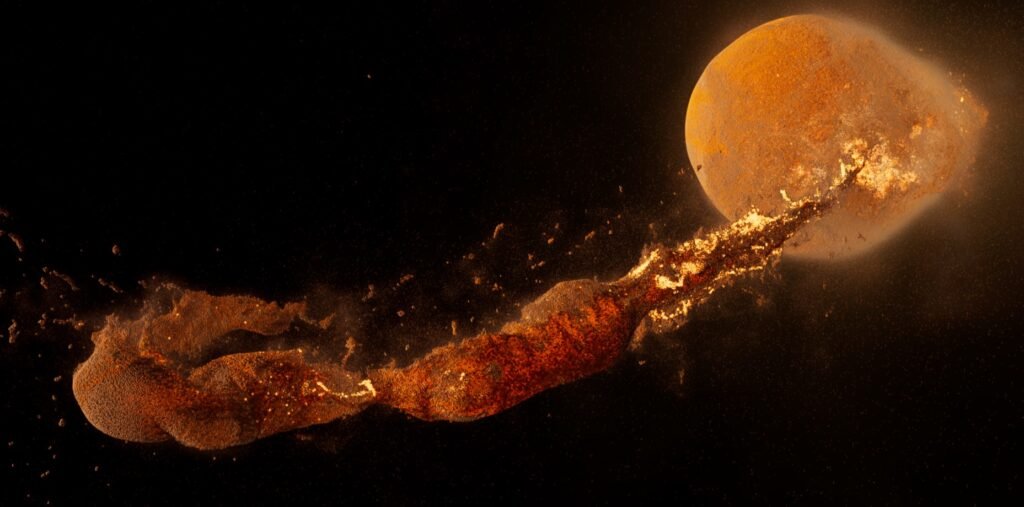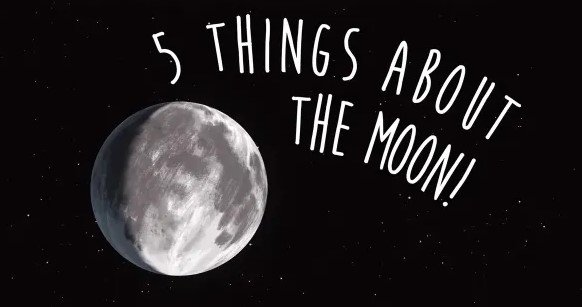What are 5 facts about the Moon? The Moon, Earth’s only natural satellite, is an enigmatic and fascinating celestial body that has captured human imagination for millennia. While it might be a familiar presence in our night sky, the Moon is full of intriguing facts and scientific wonders. In this article, we will explore five captivating facts about the Moon, delving into its formation, structure, influence, and mysteries that continue to intrigue scientists and stargazers alike.
1. The Moon Was Formed from a Giant Impact

One of the most compelling theories about the Moon’s formation is the Giant Impact Hypothesis, which suggests that the Moon was created from debris resulting from a colossal collision between Earth and a Mars-sized body named Theia.
- The Giant Impact Hypothesis: This widely accepted theory proposes that about 4.5 billion years ago, Theia collided with the young Earth. The impact was so powerful that it ejected a massive amount of debris into space, which eventually coalesced to form the Moon.
- Evidence Supporting the Theory: The similarity in isotopic composition between Earth and Moon rocks supports the Giant Impact Hypothesis. Samples collected during the Apollo missions revealed that Moon rocks share chemical similarities with Earth’s mantle, suggesting a common origin.
- Simulations and Models: Advanced computer simulations and models have been used to recreate the impact scenario, supporting the plausibility of this theory and providing insights into the early dynamics of the Earth-Moon system.
2. The Moon’s Surface is Covered in Craters and Maria
The Moon’s surface is characterized by a unique and varied landscape, featuring craters, maria, and highlands that provide a glimpse into its geological history.

- Craters: The Moon’s surface is dotted with thousands of craters, formed by the impact of asteroids and meteoroids over billions of years. Unlike Earth, the Moon lacks an atmosphere to protect it from these impacts, resulting in a heavily cratered terrain.
- Largest Crater: One of the largest craters is the South Pole-Aitken Basin, stretching over 2,500 kilometers (1,550 miles) in diameter and reaching depths of up to 13 kilometers (8 miles). This ancient impact site offers clues to the Moon’s early history and internal structure.
- Maria (Seas): The dark, flat regions on the Moon’s surface are called maria (Latin for “seas”), formed by ancient volcanic activity. These basaltic plains cover about 16% of the Moon’s surface and are primarily located on the side facing Earth.
- Formation of Maria: The maria were created by lava flows that filled large impact basins during the Moon’s early volcanic activity. The most prominent maria include the Sea of Tranquility and the Sea of Serenity, both of which are visible to the naked eye from Earth.
- Highlands: The Moon’s highlands are rugged, mountainous regions that appear lighter in color than the maria. They are composed of older, anorthosite rocks and represent some of the Moon’s oldest surfaces.
3. The Moon’s Gravity Causes Tides on Earth
One of the most well-known effects of the Moon is its influence on Earth’s tides. The gravitational pull of the Moon causes the oceans to bulge, leading to the rhythmic rise and fall of sea levels.

- How Tides Work: The gravitational attraction between the Earth and the Moon pulls the ocean water toward the Moon, creating a high tide on the side of the Earth facing the Moon. Simultaneously, a second high tide occurs on the opposite side of the Earth due to the centrifugal force of Earth’s rotation.
- Spring and Neap Tides: Tides are further influenced by the relative positions of the Sun, Moon, and Earth. Spring tides occur during the full moon and new moon phases, when the Sun and Moon align, leading to more pronounced high and low tides. Neap tides occur during the first and third quarters of the lunar cycle when the Sun and Moon are at right angles, resulting in less extreme tidal variations.
- Impact on Marine Life: Tides play a crucial role in the coastal ecosystems, influencing marine life behaviors such as feeding and breeding. Organisms have adapted to the tidal cycles, relying on them for survival and reproduction.
4. The Moon is Slowly Moving Away from Earth
The Moon is gradually drifting away from Earth, a phenomenon with significant implications for our planet’s future and the dynamics of the Earth-Moon system.

- Rate of Recession: The Moon is receding from Earth at an average rate of about 3.8 centimeters (1.5 inches) per year. This process is caused by the transfer of Earth’s rotational energy to the Moon, resulting in a gradual increase in the Moon’s orbital distance.
- Historical Measurement: The recession rate of the Moon was first measured using retroreflectors left on the lunar surface by Apollo astronauts. By bouncing laser beams off these reflectors, scientists have been able to calculate the precise distance between Earth and the Moon, confirming the Moon’s gradual drift.
- Implications for Earth: As the Moon moves farther away, its gravitational influence on Earth will diminish, leading to longer days and altered tidal patterns over millions of years. The slowing of Earth’s rotation may also impact the stability of the planet’s climate and ecosystems.
- The Future of the Earth-Moon System: In the distant future, the Moon’s recession will result in significant changes to Earth’s tides and rotational dynamics. Although the effects are gradual, they offer valuable insights into the long-term evolution of planetary systems.
5. The Far Side of the Moon Remains Mysterious
The Moon always shows the same face to Earth due to a phenomenon called synchronous rotation. As a result, the far side of the Moon, often mistakenly referred to as the “dark side,” remains largely hidden and enigmatic.
- Synchronous Rotation: The Moon takes approximately 27.3 days to orbit Earth and rotate on its axis, resulting in the same side always facing Earth. This synchronous rotation means that the far side remains unseen from our perspective on Earth.
- Exploration of the Far Side: Although hidden from direct view, the far side of the Moon has been extensively studied using spacecraft and lunar missions. The first images of the far side were captured by the Soviet spacecraft Luna 3 in 1959, revealing a rugged landscape distinct from the near side.
- Features of the Far Side: The far side of the Moon is characterized by a higher density of craters and fewer maria compared to the near side. Its unique geology offers insights into the Moon’s formation and history, prompting continued exploration and scientific inquiry.
- Recent Missions: The Chinese mission Chang’e 4 made history in 2019 by landing on the far side of the Moon, conducting experiments and providing valuable data about this mysterious region. The mission’s success highlights the growing interest in exploring the far side’s uncharted territory.
What are 5 facts about the Moon? Conclusion
These five facts about the Moon reveal its fascinating characteristics and the profound influence it has on our planet. From shaping Earth’s tides to offering insights into the solar system’s history, the Moon continues to be a subject of scientific exploration and human curiosity. As we continue to study this celestial companion, we uncover more about its mysteries and its role in shaping the cosmos.

